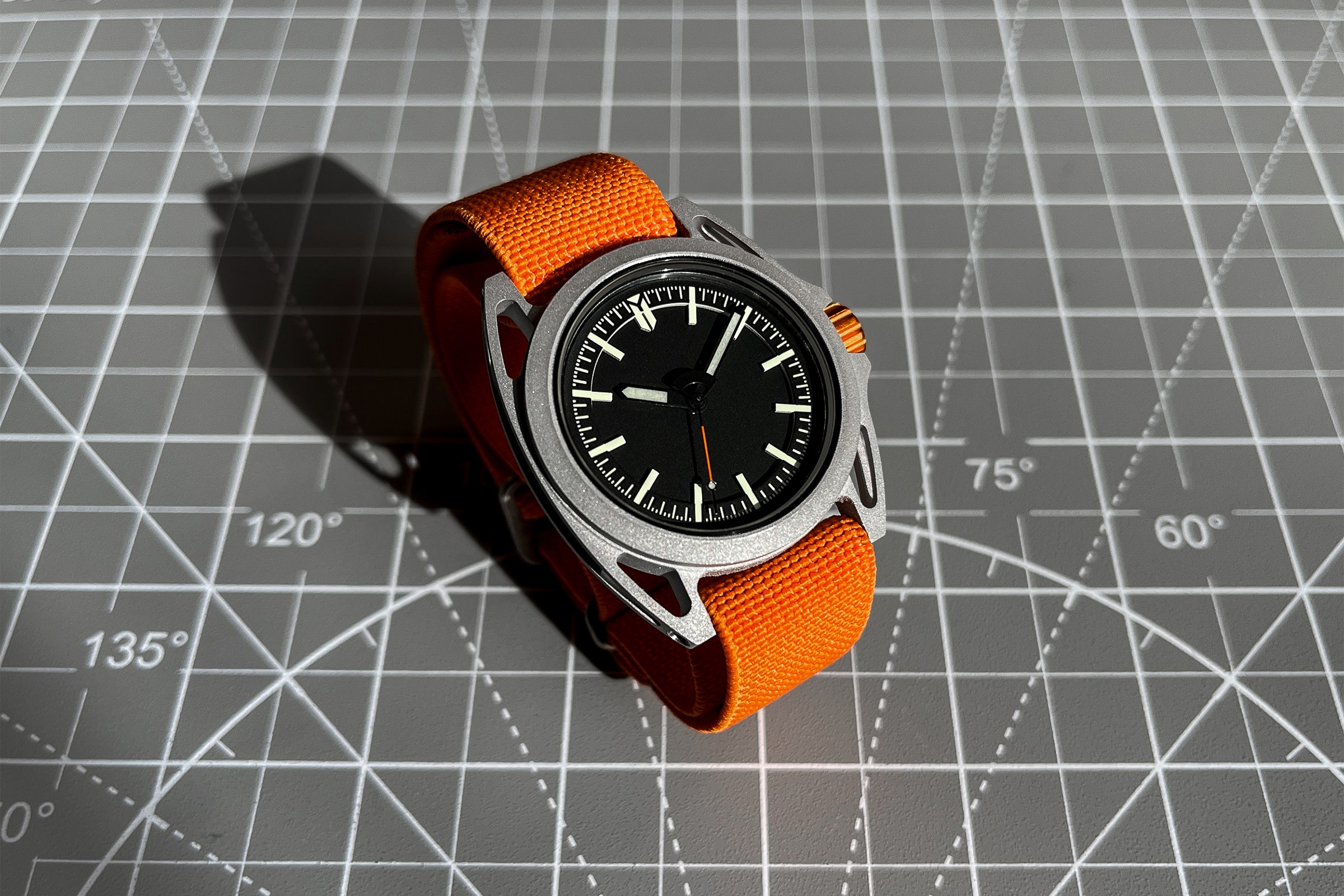When you think of space exploration and watches, one name immediately comes to mind: Omega. Since its Speedmaster chronograph was selected by NASA half a century ago it has become synonymous with space travel. The timing of a 13-second engine burn to save Apollo 13 cemented its role in space history, and Omega has not missed a single opportunity to deepen the partnership, from officially naming it the Moonwatch to creating endless commemorative limited editions (even if it is by no means the only watch that’s left our planet.)
Now, with private spaceflight proliferating and manned missions to the Moon back on NASA’s agenda, a Californian start-up wants to establish a new standard for space watches. Barrelhand, whose watches draw on expertise in 3D printing and materials science, says that its Monolith will be the only watch purpose-built for space exploration.
“Space is the harshest environment we’ve ever gone to,” says founder Karel Bachand. “When we first did it 50 years ago, there were no tools for it. NASA just tried to find off-the-shelf watches that were the best available. When the Speedmaster was selected it was never designed with space in mind, it just happened to pass the tests better than others. There was still plenty of room for improvement.”
Bachand says that even during testing, NASA’s engineers flagged that the Speedmaster’s accuracy suffered under extreme temperatures or acceleration, and there were other known issues, too. “Lume was flaking off,” says Bachand, “or the strap was getting caked up with moon dust, because it’s Velcro. There are tons of opportunities for improvements, but in the last 50 years, there’s been no innovation, especially for such a key tool that’s life or death in space exploration.”
Omega would say that its Speedmaster Skywalker X-33 model, which has been tested and qualified for use in space by the European Space Agency, is the modern answer to the Speedmaster. But it has some shortcomings—for instance, it is not certified for EVA (Extra Vehicular Activity).
“The X-33 was a great step forward”, says Bachand, “But is only rated for Intra-Vehicular Activity use due to the electronics on board. The liquid crystal display would essentially freeze up on a spacewalk. You need mechanical performance; something that can keep track of time when all other systems fail.”
Quartz watches such as the X-33 would also be vulnerable to the higher levels of radiation in outer space, which can damage various electronic components. A mechanical watch has no such trouble, but needs to be able to function in a more extreme range of temperatures than it would ever face on earth.
The Monolith case is 3D printed from an alloy of scandium, aluminum and magnesium usually used in aerospace components.
Photograph: Barrelhand
The Monolith, which is still in its prototype stage, uses a modified Sellita SW300-1b movement. Chosen for its rugged nature and ease of service, the movement has been upgraded by Barrelhand for improved magnetic resistance, shock resistance and daily accuracy of +/- four seconds.
Bachand, who has a degree in mechanical engineering as well as experience designing clinostat machinery (devices used to study the effects of microgravity on lifeforms) for NASA, founded Barrelhand in 2014. The company produced its first watch, the Project One, in 2020; listed as one of 20 semifinalists for the LVMH Watch Prize, it was a showcase for the 3D-printed construction that is at the heart of the Monolith design.
Bachand, who says that engineering for extreme temperature is the single hardest challenge to overcome, is evangelical about the potential for additive manufacturing to solve this, and other problems. By designing a case with an air pocket within its walls, Bachand was able to construct an insulating layer that allows the Monolith to work between the staggeringly inhospitable temperature range between -120°C (-184°F) and +120°C (248°F).
It has also allowed Barrelhand to work with high-performance materials: the Monolith case is printed from something called “scalmalloy”, an alloy of scandium, aluminum and magnesium that’s usually used in small-scale aerospace components.
“We get the same strength specs as titanium for half the weight, which is insane” says Bachand, “The watch weighs around one ounce—about 32 to 33 grams. We’re not designing it to be an ultralight watch, but for space exploration, every gram counts. To send one kilogram to the moon right now costs about $1.4m—so if you can shave a couple of grams off, it makes a difference.”
Barrelhand’s first watch was the Project One, released in 2020
Photograph: Barrelhand
While EVA use might be the most extreme scenario, Bachand says there is also an enormous amount of innovation required to make a watch that’s genuinely suited for use within the ISS or other spacecraft. He has given the Monolith a shatter-proof crystal that dents under impact, for example, to avoid “floating shrapnel.” The movement screws have been redesigned to make the watch serviceable with standard tools already found on the space station.
Bachand even threw out the industry-standard rubber gaskets used to seal a watch case against water. “That will start to degrade below -40°C,” he says. “We looked at the airlocks for the ISS and found a partner that can make an O-ring seal with a similar chemical makeup—an aerospace grade fluorosilicone that won’t get brittle when it freezes.”
Every single component has been considered for properties that wouldn’t even be considered on Earth—such as the phenomenon of “outgassing”, the emission of absorbed gases into the surrounding atmosphere. “If you’ve ever opened up a plastic product off Amazon you’ll remember being greeted by a harsh chemical smell, commonly known as VOCs [volatile organic compounds]. On Earth, we can just crack open a window and air it out, but the ISS does not have that luxury,” says Bachand, explaining why the Monolith uses only materials that don’t emit VOCs.
As well as reimagining the idea of a space-going watch, Barrelhand says that in the process (more or less by default) it will create a tool watch that can cope with anything on Earth. For instance, the Monolith is pressure-tested to depths of 580 meters. Bachand says that here, too, the use of 3D printing is key, and that, slowly, they are changing perceptions of a technology generally only associated with design prototyping.
“We used Project One as a research platform to test new metal 3D printing. For watches, it’s kind of the holy grail of engineering: It’s super small and super precise,” says Bachand. “If you can make a movement bridge, you’ve really shown the maturity of the technology. When I show that [to watchmakers], it’s exciting for them.”
Photograph: Barrelhand
Nevertheless, the end goal is to see the Monolith used in space—and that may prove to be a challenge that goes beyond pure engineering ability. Bachand says that submitting equipment to NASA is a bureaucratic, timely process, and that Omega’s half-century of investment will present its own obstacles. While he follows the official route, Barrelhand is simultaneously taking a “grass roots” approach, courting individual astronauts and scientists who can potentially be more easily convinced of its merits.
“Everyone that we’ve spoken to really understands the mission and sees the need for it, the need for innovation and to continue improving on any tool,” says Bachand. “A lot of astronauts are watch collectors, but they’re also just interested in tools and innovation. They don’t always care about history or the status quo; they just want whatever’s the best. When people get it in their hands and understand the specs, and the thought behind it all, I think it’s going to be a no-brainer.”




